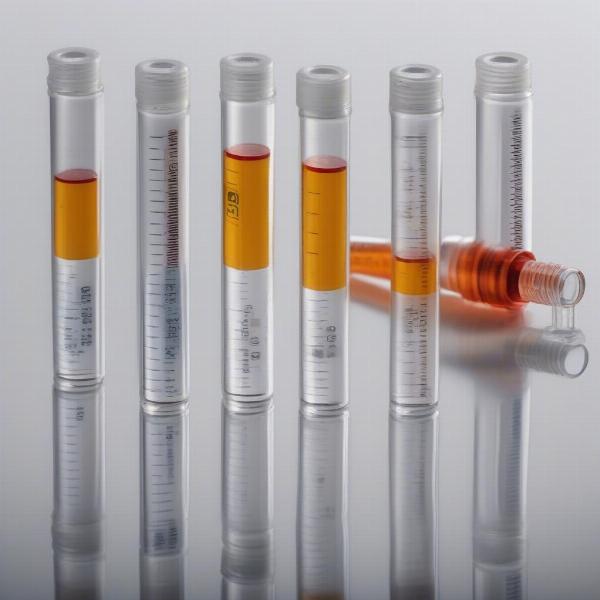Administering insulin to your dog can feel daunting, but with the right knowledge and tools, it can become a manageable part of your routine. This guide covers everything you need to know about insulin syringes for dogs, from choosing the correct size to safe injection techniques.
Understanding Insulin Syringes for Dogs
Insulin syringes are specifically designed for administering insulin. They are different from regular syringes and crucial for accurate dosage. Using the wrong type of syringe can lead to serious health complications for your dog. Choosing the right syringe and understanding its components is the first step to safe and effective insulin management.
Choosing the Right Syringe Size
The concentration of insulin prescribed for your dog (U-100 is most common) determines the type of syringe you need. U-100 insulin requires a U-100 syringe. Never use a different type of syringe. The dosage will also dictate the volume of the syringe you choose. Smaller dogs often require smaller doses and therefore smaller syringes (e.g., 0.3ml or 0.5ml), while larger dogs might need larger volumes (e.g., 1ml). Your veterinarian will guide you on the appropriate syringe size and units for your dog’s specific needs.
 Choosing the Right Insulin Syringe Size for Dogs
Choosing the Right Insulin Syringe Size for Dogs
Parts of an Insulin Syringe
Understanding the parts of an insulin syringe is essential for accurate dosing. The syringe consists of a needle, a barrel with unit markings, and a plunger. The needle should be fine and sharp to minimize discomfort for your dog. The barrel is marked with units, not milliliters, specifically designed for insulin measurement. The plunger is used to draw up and inject the insulin.
Preparing and Administering Insulin
Proper preparation and injection technique are vital for your dog’s health. Follow these steps for safe and effective insulin administration.
Preparing the Insulin
Always wash your hands thoroughly before handling insulin. Gently roll the insulin vial between your palms to mix it—never shake it. Check the expiration date and ensure the insulin is not cloudy or discolored. Attach the needle to the syringe, draw air into the syringe equal to the required dose, and inject this air into the insulin vial. Then, invert the vial and carefully draw the correct dose of insulin into the syringe, ensuring there are no air bubbles.
Injecting the Insulin
Your veterinarian will show you the proper injection technique, usually subcutaneous (under the skin). Common injection sites include the scruff of the neck, the flanks, or the abdomen. Rotate injection sites to prevent lipodystrophy (changes in the fatty tissue). Pinch up a fold of skin, insert the needle at a 45-degree angle, and inject the insulin slowly. Do not rub the injection site after removing the needle. Always dispose of used needles safely in a sharps container.
Common Concerns and Troubleshooting
Addressing common concerns and knowing how to troubleshoot potential issues will make insulin administration smoother.
What if my dog resists the injection?
Distracting your dog with a treat or having someone else hold them can be helpful. Make sure you are using a sharp needle and injecting smoothly. Never force the injection. If your dog continues to resist, consult your veterinarian for advice.
What if I accidentally inject the wrong dose?
Contact your veterinarian immediately if you suspect you have given the wrong dose. They will advise you on the best course of action based on the specific situation.
Conclusion
Administering insulin to your dog requires careful attention to detail and a commitment to following the correct procedures. With practice and patience, you can become proficient in managing your dog’s diabetes. Remember to always consult with your veterinarian if you have any questions or concerns.
FAQs
-
How do I store insulin? Unopened insulin should be stored in the refrigerator. Once opened, follow the manufacturer’s instructions for storage.
-
Can I reuse insulin syringes? Never reuse insulin syringes. Always use a new, sterile syringe for each injection.
-
My dog seems lethargic after the injection. Is this normal? Lethargy can be a sign of low blood sugar. Contact your veterinarian immediately.
-
What are the signs of diabetes in dogs? Increased thirst, increased urination, increased appetite, weight loss, and lethargy are common signs.
-
How often do I need to give my dog insulin? Your veterinarian will determine the frequency and dosage based on your dog’s individual needs.
-
Can diet help manage my dog’s diabetes? A prescribed diabetic diet is essential for managing diabetes in dogs.
-
Where can I buy insulin syringes? Your veterinarian can provide you with insulin syringes or prescribe them for purchase at a pharmacy.
About ILM Dog
ILM Dog is your trusted source for comprehensive dog care information. We offer expert advice on everything from breed selection and health care to training, nutrition, grooming, and more. Whether you’re a new dog owner or a seasoned pro, our articles provide valuable insights to help you provide the best possible care for your canine companion. For expert advice on dog health and care, including information on choosing the right products and accessories, contact us at [email protected] or call us at +44 20-3965-8624. Visit us online at ILM Dog.